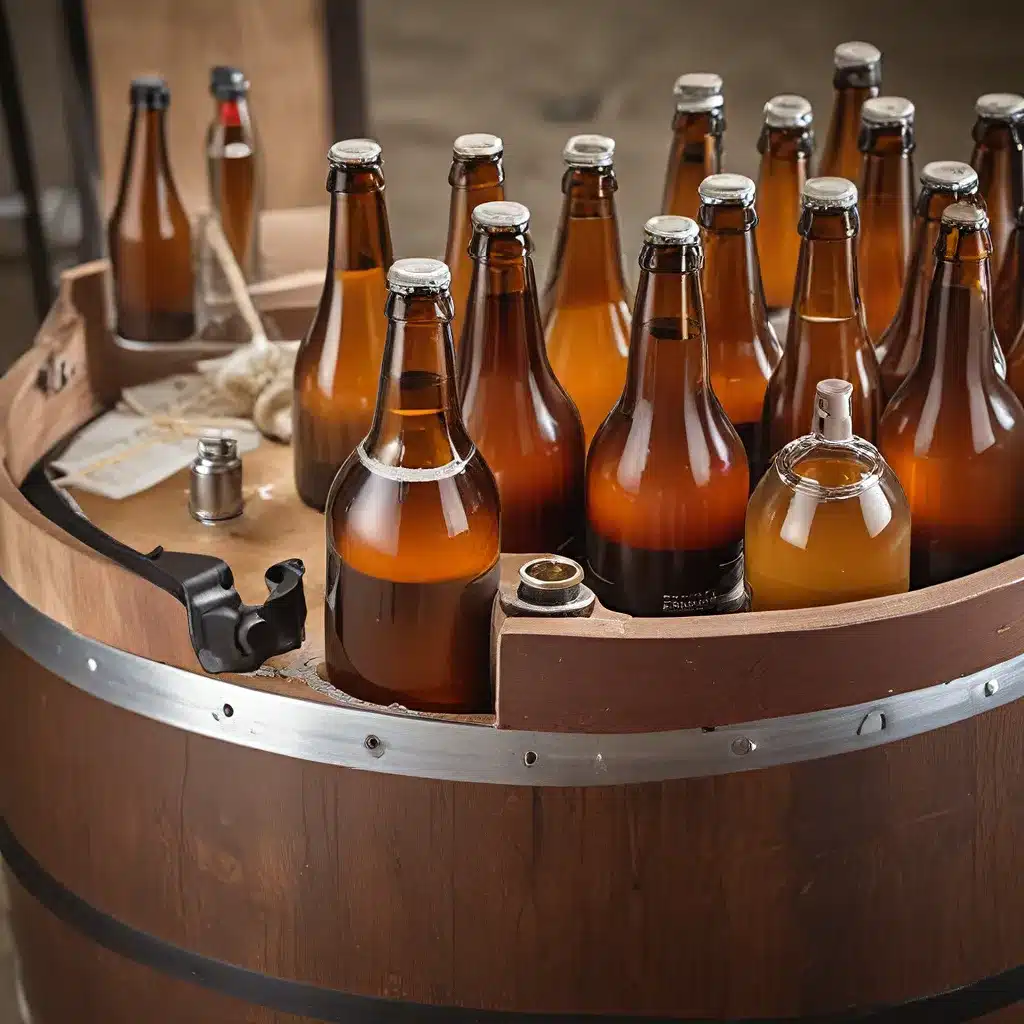
Ah, the alluring art of bottle conditioning – a secret technique that can transform your humble homebrew into a carbonated masterpiece worthy of the finest pubs and restaurants. As a lifelong homebrewer, I’ve had the privilege of witnessing this alchemy firsthand, and let me tell you, it’s a rabbit hole that’s worth diving into.
The Bottle Conditioning Journey Begins
Remember that first batch of homebrew you crafted, the one that tasted a little… flat? Yeah, I’ve been there too. But fear not, my fellow brewing enthusiasts, for bottle conditioning holds the key to unlocking the bubbly, nuanced flavors that will have your friends and neighbors clamoring for more.
It all starts with that final step in the brewing process – transferring your freshly fermented beer into bottles and adding a touch of sugar. This seemingly simple act sets off a chain reaction that’s nothing short of magical. The remaining yeast in your beer, hungry for those sugary morsels, spring into action, diligently converting those simple sugars into carbon dioxide.
“Bottle conditioning is like a little party happening inside each and every bottle, with the yeast as the guest of honor.”
As the CO2 accumulates, it becomes trapped within the liquid, creating those delightful bubbles that dance across your tongue. But the wonders of bottle conditioning don’t stop there. Oh no, my friends, this is where the real fun begins.
Unlocking the Depth of Flavor
You see, the act of bottle conditioning doesn’t just introduce carbonation – it also allows for the development of a whole new layer of flavors. As the yeast continues to work its magic, it produces a variety of byproducts, such as esters and phenols, that can impart subtle nuances to your beer.
“It’s like a symphony of flavors, with the yeast as the conductor, coaxing out the most harmonious notes from your brew.”
Imagine a crisp, clean lager that suddenly takes on a hint of spice or a rich, malty stout that develops a velvety smoothness. These are the kinds of transformations that bottle conditioning can bring about, elevating your beer to new heights of complexity and depth.
Norm Ryder, a homebrewing legend with over 50 years of experience, shared with me his secret to achieving that perfect balance of flavors:
“I tend to brew one tried-and-true recipe and one experimental recipe each brew day. This dual-approach keeps my 22 kegs full and my bottles conditioning in the fruit cellar, just waiting to be uncapped and enjoyed.”
The Art of Timing and Temperature
Of course, as with any culinary pursuit, there’s an art to mastering the timing and temperature when it comes to bottle conditioning. Too little time, and your beer may remain flat and lifeless. Too much time, and you risk the dreaded over-carbonation, leading to bottle explosions and sticky messes.
“Bottle conditioning is like a delicate dance, where every step must be carefully choreographed to achieve the perfect balance.”
I remember the first time I tried to bottle condition a batch of homebrew. I was so eager to taste the results that I couldn’t resist cracking open a bottle after just a week. The result? A geyser of foam that nearly covered my kitchen in a sticky, amber shower. Needless to say, I learned my lesson the hard way.
But fear not, my fellow brewers, for with a little patience and attention to detail, you can nail the bottle conditioning process every time. The key is to follow the recipe’s guidelines to the letter, allowing the yeast the time it needs to work its magic without going overboard.
Embracing the Unpredictable
Now, I know what you’re thinking – “But what if I mess it up? What if my beer turns out flat or, worse, explodes all over my carefully curated collection of brewing equipment?” Well, let me tell you, the beauty of homebrewing lies in the unpredictable nature of it all.
“Bottle conditioning is like a choose-your-own-adventure novel – you never quite know what you’re going to get, and that’s half the fun!”
Just like the iconic Fuller’s ales that have graced the taps of pubs and restaurants for generations, your homebrew is a reflection of your unique journey as a brewer. Each batch is a story waiting to be told, and even the “mistakes” can often lead to the most interesting plot twists.
Remember that first time you bottled your beer and found that one bottle was somehow overcarbed, while the rest were perfectly carbonated? Instead of pouring it down the drain, you decided to give it a try, and lo and behold, you discovered a new flavor profile that you never would have stumbled upon otherwise.
Embracing the Journey
So, my fellow homebrewers, as you embark on your bottle conditioning adventures, remember to embrace the journey. Savor the process, revel in the unpredictability, and most importantly, don’t be afraid to experiment. After all, that’s what makes this hobby so darn rewarding.
“Bottle conditioning is like a never-ending treasure hunt, where the real prize is the joy of discovery.”
Who knows, maybe your next batch will be the talk of the local pub, with customers clamoring for the secret behind your perfectly carbonated masterpiece. Or perhaps you’ll stumble upon a new flavor combination that will forever change the way you approach your brewing. The possibilities are endless, my friends, and the journey is just beginning.
So, grab your bottles, your sugar, and your patience, and let’s dive headfirst into the world of bottle conditioning. The rewards, I can assure you, are well worth the effort. Cheers to your future successes, and don’t forget to stop by The Up & Under Pub to share your latest creation with like-minded enthusiasts.

